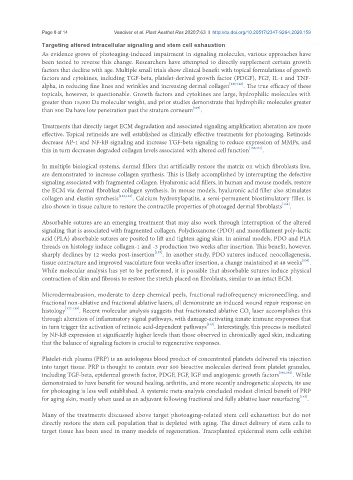Page 744 - Read Online
P. 744
Page 8 of 14 Vandiver et al. Plast Aesthet Res 2020;7:63 I http://dx.doi.org/10.20517/2347-9264.2020.159
Targeting altered intracellular signaling and stem cell exhaustion
As evidence grows of photoaging-induced impairment in signaling molecules, various approaches have
been tested to reverse this change. Researchers have attempted to directly supplement certain growth
factors that decline with age. Multiple small trials show clinical benefit with topical formulations of growth
factors and cytokines, including TGF-beta, platelet-derived growth factor (PDGF), FGF, IL-1 and TNF-
alpha, in reducing fine lines and wrinkles and increasing dermal collagen [126-128] . The true efficacy of these
topicals, however, is questionable. Growth factors and cytokines are large, hydrophilic molecules with
greater than 15,000 Da molecular weight, and prior studies demonstrate that hydrophilic molecules greater
than 500 Da have low penetration past the stratum corneum [129] .
Treatments that directly target ECM degradation and associated signaling amplification alteration are more
effective. Topical retinoids are well established as clinically effective treatments for photoaging. Retinoids
decrease AP-1 and NF-kB signaling and increase TGF-beta signaling to reduce expression of MMPs, and
this in turn decreases degraded collagen levels associated with altered cell function [130,131] .
In multiple biological systems, dermal fillers that artificially restore the matrix on which fibroblasts live,
are demonstrated to increase collagen synthesis. This is likely accomplished by interrupting the defective
signaling associated with fragmented collagen. Hyaluronic acid fillers, in human and mouse models, restore
the ECM via dermal fibroblast collagen synthesis. In mouse models, hyaluronic acid filler also stimulates
collagen and elastin synthesis [132,133] . Calcium hydroxylapatite, a semi-permanent biostimulatory filler, is
also shown in tissue culture to restore the contractile properties of photoaged dermal fibroblasts [134] .
Absorbable sutures are an emerging treatment that may also work through interruption of the altered
signaling that is associated with fragmented collagen. Polydioxanone (PDO) and monofilament poly-lactic
acid (PLA) absorbable sutures are posited to lift and tighten aging skin. In animal models, PDO and PLA
threads on histology induce collagen-1 and -3 production two weeks after insertion. This benefit, however,
sharply declines by 12 weeks post-insertion [135] . In another study, PDO sutures induced neocollagenesis,
[136]
tissue contracture and improved vasculature four weeks after insertion, a change maintained at 48 weeks .
While molecular analysis has yet to be performed, it is possible that absorbable sutures induce physical
contraction of skin and fibrosis to restore the stretch placed on fibroblasts, similar to an intact ECM.
Microdermabrasion, moderate to deep chemical peels, fractional radiofrequency microneedling, and
fractional non-ablative and fractional ablative lasers, all demonstrate an induced wound repair response on
histology [137-139] . Recent molecular analysis suggests that fractionated ablative CO laser accomplishes this
2
through alteration of inflammatory signal pathways, with damage-activating innate immune responses that
in turn trigger the activation of retinoic acid-dependent pathways [140] . Interestingly, this process is mediated
by NF-kB expression at significantly higher levels than those observed in chronically aged skin, indicating
that the balance of signaling factors is crucial to regenerative responses.
Platelet-rich plasma (PRP) is an autologous blood product of concentrated platelets delivered via injection
into target tissue. PRP is thought to contain over 800 bioactive molecules derived from platelet granules,
including TGF-beta, epidermal growth factor, PDGF, FGF, IGF and angiogenic growth factors [141,142] . While
demonstrated to have benefit for wound healing, arthritis, and more recently androgenetic alopecia, its use
for photoaging is less well established. A systemic meta-analysis concluded modest clinical benefit of PRP
for aging skin, mostly when used as an adjuvant following fractional and fully ablative laser resurfacing [143] .
Many of the treatments discussed above target photoaging-related stem cell exhaustion but do not
directly restore the stem cell population that is depleted with aging. The direct delivery of stem cells to
target tissue has been used in many models of regeneration. Transplanted epidermal stem cells exhibit

